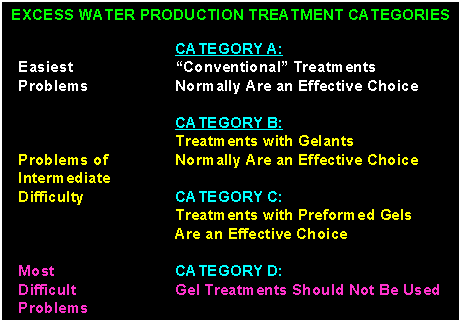Proposed Strategy
A Strategy for Attacking Excess Water Production
- Consider and eliminate easiest problems first
- Start by using information you already have
Our proposed strategy for attacking excessive water production problems advocates that (1) the easiest problems should be attacked first and (2) diagnosis of water production problems should begin with information already at hand. To implement this strategy, a prioritization of water production problems is needed. Based on extensive reservoir and completion engineering studies and analyses of many field applications, the various types of water problems were prioritized and categorized from least to most difficult. This prioritization is listed in Table 1. The first three listings are the easiest problems (Category A, Problems 1-3), and their successful treatment has generally been regarded as relatively straightforward. Of course, individual circumstances can be found within any of these problem types that are quite difficult to treat successfully. For example, for Problem Type 3, impermeable barriers may separate water and hydrocarbon zones. However, if many water and oil zones are intermingled within a short distance, it may not be practical to shut off water zones without simultaneously shutting off some oil zones. The ranking of water production problems in Table 1 is based on conceptual considerations and issues related to the ease of treating each type of problem. We realize that operational and practical issues can make even the easiest problems in Table 1 very difficult solve in practice.
Nevertheless, the first three problem types in Table 1 are generally easier in practice to treat than the others on the list. Therefore, one should look first for these types of problems
In contrast, the last three problems (Category D, Problems 11-13) are difficult with no easy, low-cost solution. (Gel treatments will almost never work for these problems.) The intermediate problems (Categories B and C, Problems 4-10) are caused by linear-flow features (e.g., fractures, fracture-like structures, narrow channels behind pipe, or vug pathways). Certainly, much work remains to optimize the treatment of these problem types. However, substantial theoretical, laboratory, and field progress has been made in recent years toward solving these problems—especially using gels. As will be discussed shortly, Problems 4-7 (Category B in Table 1) normally are best solved using gelants—i.e., the fluid gel formulation before significant crosslinking occurs. Problems 8-10 (Category C) are best solved using preformed or partially formed gels (i.e., crosslinking products that will not flow into or damage porous rock).

A key element of the proposed strategy is to look for and solve the easiest problems in Table 1 before attempting to attack the more difficult problems. In many cases, engineers initially assumed that three-dimensional coning (Problem 11 in Table 1) caused the problem, whereas a small amount of subsequent diagnosis and analysis revealed the true source of water production was either flow behind pipe (Problem 2) or “two-dimensional coning” through a fracture (Problem 6). This knowledge could have substantially reduced the cost of solving the problem (since Problems 2 and 6 can be solved with relatively low-cost methods, whereas Problem 11 cannot). Also, by correctly identifying the problem first, the most appropriate method can be identified and the probability of successfully treating the problem increases significantly.
To help implement the proposed strategy, the following questions should be addressed in the order listed: